Randolph "Ran" Preston Shaffner, a 1940 native of Winston-Salem, N.C., has been teaching, writing, and publishing professionally since the 1960s. His fields of interest have ranged from world literature and literary criticism to creative nonfiction, history, poetry, and biography.
He attended Davidson College and earned his degree in English with honors in writing from the University of North Carolina at Chapel Hill. He went on at Chapel Hill to complete his master's and doctorate in comparative literature, specializing in European Romanticism. He studied German as a Goethe Institute Scholar through the German Embassy in Munich and French at the University of Besançon.
He taught English as a Foreign Language for the U.S. Peace Corps in Thailand at Damrongrartsongkroh School in 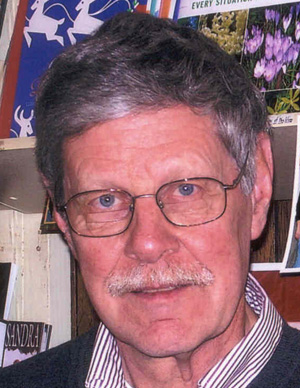 Chiengrai and at Kasetsart University in Bangkok. He taught English and French at St. Christopher's School in Richmond, Virginia; English and Comparative Literature at the University of North Carolina at Chapel Hill; English and World Literature at Fairfield University in Connecticut; and Great Books in Highlands, N.C., for Western Carolina University at Cullowhee. Chiengrai and at Kasetsart University in Bangkok. He taught English and French at St. Christopher's School in Richmond, Virginia; English and Comparative Literature at the University of North Carolina at Chapel Hill; English and World Literature at Fairfield University in Connecticut; and Great Books in Highlands, N.C., for Western Carolina University at Cullowhee.
His publications include a world survey of the Apprenticeship Novel and several books, articles, and DVDs on a variety of historical subjects, for which he has received book and multimedia awards from the North Carolina Society of Historians and the American Association for State and Local History. He has authored several National Register and North Carolina Historical Highway Marker nominations. His more than seventy lectures, delivered at public and private venues, have focused primarily on historical, literary, religious, and occasional topics. In 2019 he was awarded the North Carolina Society of Historians' highest honor: HISTORIAN OF THE YEAR AWARD for the many valuable contributions he has made toward the collection, preservation and perpetuation of North Carolina's rich history."
Ran and his wife, Margaret, have five sons and six grandchildren. They live in the mountains of Western North Carolina, where he established and managed for almost thirty years Cyrano's Bookshop and Faraway Publishing. In retirement he now serves as cofounder and archivist emeritas for the Highlands Historical Society and cofounder and board member of the Highlands Plateau Greenway. For years he and his wife maintained the Whiteside Mountain Trail for the U.S. Forest Service. They currently divide their time between Highlands and Givens Highland Farms in Black Mountain, N. C.
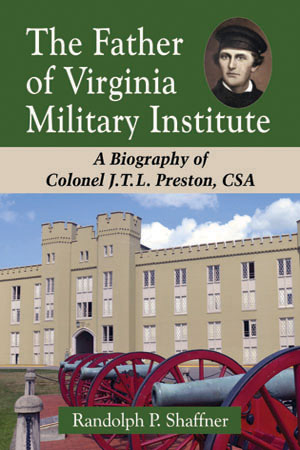 THE FATHER OF VIRGINIA MILITARY INSTITUTE THE FATHER OF VIRGINIA MILITARY INSTITUTE
The Virginia Military Institute launched an educational revolution when it became the first school in the American South to combine classical and practical courses under an effective system of military discipline. It pioneered free schooling for the poor and exemption from tuition and board in exchange for two years of teaching in primary and secondary education. It has furnished fully qualified citizen-soldiers for both civilian and military life since before the Civil War.
Who first thought of VMI has been the subject of multiple claims since the school's founding in 1839. This biography of Col J. T. L. Preston, in attempting to answer that question, unfolds the life of a teacher, soldier, husband, and father, who defined the school as it exists today, served Stonewall Jackson as his first adjutant general, married the Poetess of the Confederacy, and fathered a family whose members proudly bore the stamp of their father's inviolable character in both civilian and military life.Preston is revealed as a man of faith who suffered "anguish beyond remedy" under "the bloody, remorseless hand of war," which "tore from his heart what, to him, was more precious than liberty, home, or anything but heaven."
Published by McFarland Publishing, 2014
Available at McFarland Publishing or Amazon.com.
Reviews
"A fascinating, well-researched and long overdue biography of the Virginia Military Institute’s most unheralded founder and underappreciated champion of educational reform."
—Dr. Bradford A. Wineman, Marine Corps University
"This is a fascinating and extremely readable book, deeply researched but never pedantic. It presents a thorough and persuasive defense of Col. Preston’s unique role in the founding and preservation of V.M.I. and paints a vivid and often surprising picture not only of this one eccentric, determined reformer—schoolmate of Edgar Allan Poe and brother-in-law of Stonewall Jackson—and his family, but also of Virginia society before, during, and after the Civil War."
—J. B. McAfee (Richmond, Va.)
"This biography from McFarland Publishing has the type of massive bibliography and expansive scholarly documentation seen in quality original works. I can't say I am familiar with this particular fellow (Civil War readers encounter a lot of Prestons), but, as the title indicates, he was a key figure in the institutional development of VMI. Preston and Stonewall Jackson both married Junkin sisters, and the professor would also serve on Jackson's staff during the war."
—Civil War Books and Authors: Booknotes IV (October 2014)
"The Father of Virginia Military Institute is an easy to read accounting of an interesting and complex man, who managed to survive one of our country's most horrific periods. Colonel J.T.L. Preston's brilliance, humanity and vulnerabilities are felt throughout the book, and it was made clear by the author how these qualities drove his life and what he managed to accomplish. This wonderful read includes much information on the Southern colonel's first and second wives, both of whom he dearly loved: his first wife a fellow Southerner and his second a Northerner living as Mrs. Preston in Virginia during the battle between the States, the battle between her two worlds. The book and the time are fascinating for anyone interested in American history, in general, and the Civil War, in particular. I enjoyed every page and was sorry when the book ended. Beautifully written and thoroughly researched, giving the reader a clear view of this 19th century man and his complicated existence as a father of a family and of an institute."
—Freyda Salkin (Los Angeles, Calif.)
"Shaffner has provided readers a worthy biography of the father of VMI."
—Dr. Thomas W. Davis, VMI Emeritas Professor of History
"The book was so good that I 'rationed' it like a wonderful dessert! But alas I finally finished it. I learned so many things about VMI that I had never realized, and corrected some very wrong impressions. I was amazed that I am fortunate to share Preston’s views on teaching. That really surprised me, as I was sure that the passage of time would produce different results! But his views on the subject are forever in my view! I became so 'involved' with the Preston family that I eventually felt like a member myself. Shaffner has done a great job of capturing the man, the family and the times. I have recommended it to all of my Brother Rats."
Lt. Col. Richard S. "Hap" Miller '60 (November 2014)
"An exceptionally well written, organized and presented biography, 'The Father of Virginia Military Institute: A Biography of Colonel J.T.L. Preston, CSA' is a highly recommended addition to the growing library of Civil War Literature."
—James A. Cox, Editor-in-Chief, Midwest Book Review (December 2014)
"Until now [Col. J.T.L. Preston] has been a generally unknown figure in the background of more famous VMI figures such as Thomas "Stonewall" Jackson and George C. Marshall. This volume rectifies that situation.
"The Father of Virginia Military Institute will be attractive to VMI alumni and those interested in VMI, antebellum Virginia or Virginia's Civil War history, especially the 1864 Valley Campaign. It is highly recommended."
—Jospeh A. Derie, Civil War News (January 2015)
"Emeritus English professor Randolph Shaffner offers the first comprehensive biography of ]ohn Thomas Lewis Preston, one of the key figures in establishing the Virginia Military Institute (VMI) and one of the nation's first vocal advocates for state supported military education. What gets the lion's share of attention in this book is Preston's role in the founding of VMI itself. . . . Shaffner's work is the first to examine his life after the Institute's creation and expounds on his influence as a practitioner of education. . . . Shaffner also addresses Preston as a man of his time, examining his innermost perspectives on such issues as slavery, secession, and Reconstruction. His story is not only that of the creator of a military school but also that of a civically minded Virginian from a notable family whose eventful life spanned nearly the entire nineteenth century. The book's best and most provocative chapter examines Preston's intriguing and complex views on race and its place in American society. . . . This biography is a commendable and much overdue analysis of one of nineteenth-century Virginia's most influential intellects and underappreciated educational pioneers."
—Bradford A. Wineman, Virginia Magazine of History and Biography, Vol. 123 (2015), No. 3, pp. 276-78.
"Randolph Shaffner's biography is distinguished by superb, exhaustive use of sources that document Preston's years in Lexington, Va."
—Robert K. Krick, Civil War Times, Vol. 54, Issue 4 (Aug. 2015), p. 69.
“The author describes the life of Colonel Preston and weaves the history of the institute with Virginia society of the middle nineteenth century into a highly detailed, yet digestible, work that anyone interested in the history of military education should read. . . .The Father of Virginia Military Institute is a thorough biography of a complex man, but the author tells Preston’s story in a very readable manner, while simultaneously relating the story of his family, friends, VMI, Lexington, and Virginia society. The book would make a great first study for anyone looking at the history of one of the nation’s top military schools or for more details on its founding father. Certainly, it should be required reading for all Rats.”
—Cdr. Jeffrey B. Barta, Army History, Professional Bulletin 20-15-4 (No. 97), Fall 2015, pp. 4
"Shaffner's portrait of J.T.L. Preston makes an important contribution to our understanding of this significant nineteenth-century Virginian. The author does a commendable job of weaving together the many facets and contributions of his subject in this sympathetic profile."
—Mark F. Miller, Journal of Southern History, Vol. 82, No. 1 (Feb. 2016), pp. 159-60. |
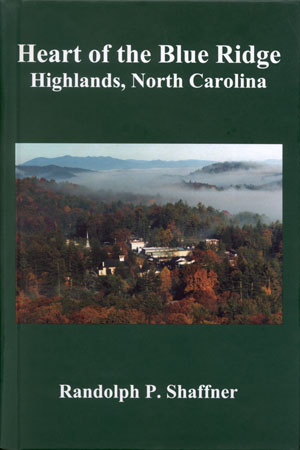 HEART OF THE BLUE RIDGE HEART OF THE BLUE RIDGE
On March 6, 1875, Sam Kelsey and C. C. Hutchinson paid $2 an acre for just over a square mile of the Sugartown Highlands in the Blue Ridge Mountains and began building a town 4,000 feet above the clouds. Perched on the shoulders of Satulah, Fodderstack, Black Rock, Whiteside, and Shortoff mountains, the Highlands Plateau was shaded by primeval forests of giant hardwoods and pyramidal pines and drained by quiet crystal streams and thundering cataracts that plunged over precipitous crags and down laurel-fringed gorges. Offering restoration of health and soul, this paradisialsettlement provided common ground for settlers from both the North and South a decade after their great Civil War. By 1883 300 immigrants from twenty-seven Northern and Southern states were calling Highlands home.
This is a history of the origin and growth of a town with a Northern climate set high in the South, including the ever-continuing struggle between those who would preserve and those who would exploit its unique appeal to year-round residents and summer visitors. In its attempt to be all-inclusive, this book contains much detail, but it also embodies a collection of matchless characters and personalities and their stories that have given the town and its history remarkable color and enduring interest. In short, the big world is here mirrored in the small world where little things that happen are no less important, indeed more so.
Recipient of the North Carolina Society of Historians History Book Award, 2002
Judges’ Comments: “What a tremendous endeavor! This book will have a profound impact on how both residents of and visitors to Highlands view the place as it was and as it is now. The author has don an exemplary job of bringing the history of the area alive through the mastery of literary technique. One is able to visualize places and buildings of the past. And, we became familiar with the people who lived and worked there . . . so much so we ‘felt’ like neighbors, like we were there when ‘life’ happened and not on the outside of the circle looking in. This book, though very thick, is worthy of being picked up and read. It is not boring and will appeal to many educational levels. The pictures included are many, interesting and inviting. With regard to presentation, the book is exceptionally well-planned. It contains a thorough table of contents, list of illustrations, index of names and places. Especially impressive are the Appendix and Bibliography sections! Very well-documented. This is a wonderful book for an absolutely fantastic price!”
Recipient of the American Association of State and Local History Award, 2005
Published by Faraway Publishing, 2001, 2nd ed. 2004
See "Books Available" at Highlands Historical Society.
Reviews
“Heart of the Blue Ridge is huge (737 pages) and exhaustively researched, but it is also a delightful and satisfying read. The book overflows with exquisite black and white images and tasty tales of the folk—rich and poor, common and famous—who have made this mountain town unique. Shaffner’s storytelling style, almost chatty at times, makes you forget you are reading ‘history.’”
—Barbara McRae, Franklin Press, Franklin, N.C.
“Ran Shaffner spent eight years researching this book. It contains over 300 photographs (many from the George Masa collection), and considered in its totality, is perhaps the most exhaustively developed ‘regional histories’ that I have ever seen. Beginning with Cherokee myth and legend, the author proceeds with detailed accounts of early history, prominent families, anecdotes, economic growth, cultural development, and a narrative account of every building in Highlands, including churches, summer resorts, local businesses, inns, post offices and roads. This daunting assemblage is obviously a labor of love and is wrapped in a narrative replete with colorful accounts of bears, possum hunt and wonderful characters—like Gus Baty, the man who “fell off of Whiteside,” and Charlie Wright, the man who saved his life. Certainly it deals with a region and a people that are unlike any other in western North Carolina.”
—Gary Carden, Sylva, N. C.
“I can’t say enough about your fantastic book! I am filled with admiration for your dedication and perseverance in creating such a clearly written and well researched memorial to a unique place and special time in our country’s history. It has jogged my memory and enriched my experience of Highlands immeasurably and reminds me once again how proud I am to be a southern boy from “the Heart of the Blue Ridge.”
—Tom Rucker, Santa Cruz, Calif.
“Your book is a wonder! I don’t know how you collected all the facts in it. It is truly a monumental work. You have rendered a service to all Highlands lovers that will live forever. You should be awarded a Carnegie Medal for travail and dedication beyond the call of duty.”
—Dr. William C. Marett, Seneca, S.C.
“Considering the work which went into this is just mind-boggling to me! At the same time, anyone who has a sense of place would be envious of the experiences you have had getting into the heart and soul of Highlands. To become such a part of a place . . . and for it to become such a part of you . . . is wonderful!
—Leland M. Park, Director, Library of Davidson College, Davidson, N.C.
“I will treasure the book as a history of the place where I grew up written by a soul who hears the ageless music of the mountains and who ‘tunes’ it in for those who have never heard it and those who forgot to listen. . . . I love the multitude of perspectives on particular topics. You graciously set aside ego and the insane requirement of finding ‘truth’ and let many voices be heard, a Blue Ridge chorus that certainly produces more truth than any solo voice could.”
—John deVille, Franklin, N.C.
“Read your book from kiver to kiver and loved every minute of it.”
—June Thompson Medlin, Lake Junaluska, N.C.
“Obviously, there’s a lot to say about the town of Highlands. Faraway Publishing’s 2001 release of Randolph P. Shaffner’s Heart of the Blue Ridge: Highlands, North Carolina has the girth of Anna Karenina. . . . Packed with archival photographs, this well-written narrative chronicles Highlands’s development and evokes the town’s charm. With the author’s exhaustive attention to all details, from the smallest to the largest, the book will undoubtedly become the definitive history of Highlands, N.C.”
—Walter T. Evans, N.C. Historical Review, vol. 74, no. 2 (April, 2002)
“A great mix of scholarly recording of fact, anecdote, and storytelling. Should be required reading for life-long Highlander and newcomer alike.”
—Frederick “Skip” Taylor, Former Editor of the Highlander
“As a descendent of pioneering families of Macon and Jackson counties, I am enthralled with Randolph Shaffner’s book, Heart of the Blue Ridge. It is by far the most complete and comprehensive history of a particular locale I have ever experienced. Having grown up under the spell of my father’s accounts of the unique people and places of Highlands, N. C., Ran’s book was in a sense like being introduced in person to numerous friends and relatives of my ancestors, along with their homes and business establishments.”
—Howard E. Alley, Highlands, N. C.
“Highlands is fortunate to have such a dedicated and skilled chronicler of its past.”
—Robert Anthony, Curator, North Carolina Collection at U.N.C.-Chapel Hill
"I'll admit I'm biased since I helped edit this book, but it's got some amazing stories. Anyone who is interested in Americana will love this book - especially my favorite picture of all time - Benson Picklesimer.
—Ted Shaffner, 2007
Randolph P. Shaffner’s “Heart of the Blue Ridge: Highlands, North Carolina” — at 737 pages, surely the world’s thickest local history per capita."
—Lew Powell, http://blogs.lib.unc.edu, Jan. 31, 2010
“A comprehensive and interesting history of Highlands. You won’t be disappointed. The chapter on the Moonshine War was worth the price of the book for me.”
—Paula Rodarmer, Sept. 21,2013 |
|
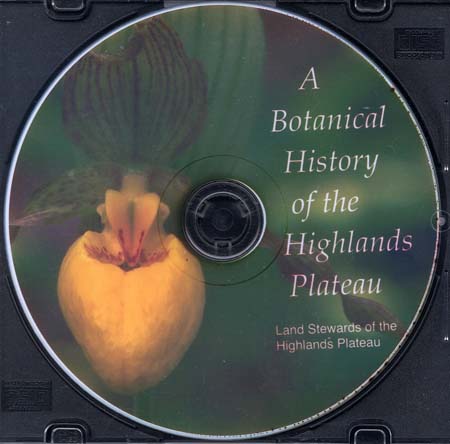 DVD: A BOTANICAL HISTORY OF THE HIGHLANDS PLATEAU DVD: A BOTANICAL HISTORY OF THE HIGHLANDS PLATEAU
IN THE FOOTSTEPS OF THE ANCIENTS
The extraordinary botanical diversity that defines the Highlands Plateau had its origins about 300 million years ago in a cataclysmic collision of continents that formed the world's oldest mountains, the Appalachians. Subsequent glaciations extinguished plant life as far south as Pennsylvania. The southern Appalachians became a refuge for northern plants, and today northern and southern plants live together in lush, very diverse landscapes produced by abundant rainfall and variable topography and soils.
This DVD was created to accompany a fascinating exhibit by the Land Stewards at the Highlands Historical Museum in North Carolina. It begins with the creation of the Appalachian mountains and features the Cherokee view of the world, the life of early settlers, the arrival of early botanists, and attempts to preserve native plants and discourage invasives on the Highlands Plateau. The video attempts to compress 300 million years into 7 minutes for those who haven't the time to read all the information in the exhibit.
Recipient of the North Carolina Society of Historians Multimedia Award, 2015
Judges Comments: “It was difficult to breathe while watching this DVD since spectacular pictures of the flora gracing the Highlands Plateau flashed on the screen! One breath-taking scene after another, vintage photographs of important people connected with the recording of the flora as well as the protection of it, and a superb script made it impossible to venture away. The captivating voice of narrator, Steve Day, kept our attention as we were educated about the history of the Highlands Plateau. This ‘education’ included natural and manmade threats to the area and how every effort has been made over the years to protect it; and, how many dedicated people currently are making an effort to educate the public and raise awareness about how important protecting the land is to Highlands. The DVD has wide appeal and takes in not only botanists, but historians, ‘conservationists and visitors to the area.’ . . . It was a pleasure to judge this entry and only disappointing seven minutes later when the video ended!”
Published by Time Capsule Video, 2014
See "Books Available" at Highlands Historical Society.
Reviews
"Fantastic! Georgeous footage, brilliantly written text, and of course Steve Day's magnificent voice. Great job. Hope this gets views by a lot of people because it is not only important history of Highlands, the conservation message is much needed."
—Cynthia Strain, Highlands, N.C.
|
 CONTEMPORARY AUTHORS CONTEMPORARY AUTHORS
NEW REVISION SERIES, VOLUME 408
(Contributor)
A biographical and bibliographical guide to current writers in all fields including poetry, fiction and non fiction, journalism, drama, television and movies. Information is provided by the authors themselves or drawn from published interviews, feature stories, book reviews and other materials provided by the authors/publishers.
Published by Gale, 2020
|
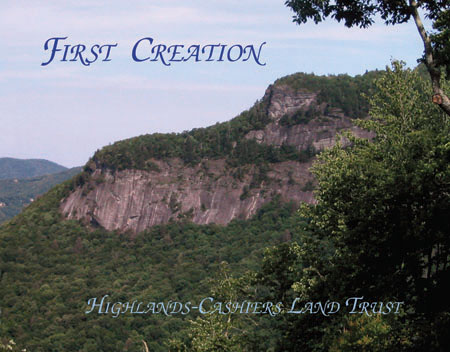 FIRST CREATION FIRST CREATION
100 YEARS OF LAND CONSERVATION
With this book the Highlands-Cashiers Land Trust celebrated the centennial of its first land purchase in 1909, making it the oldest land trust in North Carolina and one of the oldest in the United States. The book is a photographic essay of landscapes, flora, fauna, and viewscapes of the Highlands-Cashiers plateau that have been preserved for the perpetual enjoyment and benefit of the public. Established in 1883 as the Highlands Improvement Society, the Trust today protects over 2,500 acres in Western North Carolina. Proceeds from the sale of this book help support the mission and goals of the Land Trust.
Recipient of the North Carolina Society of Historians History Book Award, 2016
Judges' Comments: "The only thing that overshadows the magnificent, well-researched and chronicled text are the most breath-taking color photographs of the areas protected by this land trust. Simply spellbinding! Photographs that penetrate the mind and reach the very soul of the reader. Vintage visuals tell the story of the areas long ago, while current pictures tell the story of how these same areas are to this day. Many seem to have not suffered any 'progress,' thank goodness, due to a diligent, dedicated and determined group who not only protect the land, they protect NC history."
Published by Randolph Shaffner DBA Faraway Publishing, 2009
See "Books Available" at Highlands Historical Society. |
.jpg) IMAGES OF AMERICA: HIGHLANDS IMAGES OF AMERICA: HIGHLANDS
Perched on the crest of the Blue Ridge Mountains and founded in 1875 as a health and summer resort, the town of Highlands in Western North Carolina enjoys a northern climate in a southern setting. Its people originate from across the nation, giving an otherwise provincial village a cosmopolitan worldview, and its natural surroundings have attracted professionals in the arts and sciences as well as laborers, tradesmen, and craftsmen. The photographs in this volume attest to the extraordinary variety of characters that inhabited the Highlands plateau at the town's founding and during the first half-century of its growth and development.
This book is dedicated to the people of Highlands and its surroundings who have preserved and continue to preserve their family photographs for future generations.
Recipient of the North Carolina Society of Historians History Book Award, 2009
Published by Arcadia Publishing, 2008
Reviews
“The author begins with chapters on the region’s rich botanical diversity and physical beauty, and then briefly reviews the families who first settled the land that would become Highlands. . . . Like similar titles in Arcadia’s Images of America series, most pages have two well-printed black and white photographs, each accompanied with a one-paragraph informative caption that often includes interesting trivia. People seldom think of their old photographs with their sepia-toned images of awkwardly posed ancestors as historical documents, but Highlands proves once again how such ‘artifacts’ can express more about how people lived than dozens of pages of historical text. The author’s personal ties to the area and sense of place lend an engaging authenticity and homespun perspective to the book. Highlands is a pleasure to read and compares favorably with other titles in the series. . . . the book’s regional appeal is undeniable, and its strength is in its well-crafted portrayal of the unique families and individuals that helped to build Highlands.”
—Jeff Futch, North Carolina Historical Review, Vol. 86, No. 3 (July 2009), pp. 372-72.
"I am very happy to have this great history of Highlands. The pictures are marvelous. Several family members are mentioned, and some are pictured, so the book has a special meaning in addition to being a nice addition to my genealogy library."
—S. Fisher, "A Great Addition to My Personal Library," Feb. 19, 2018. |
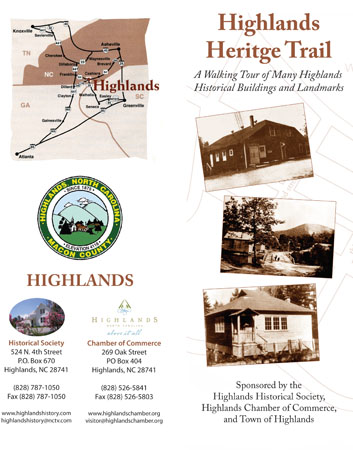 HIGHLANDS HERITAGE TRAIL HIGHLANDS HERITAGE TRAIL
The town of Highlands, in the heart of the Blue Ridge Mountains, is unique among the communities of Western North Carolina. Its chief claim to fame--while bolstered by commercial, sociological, and historical advantages--is aesthetic. It is still a small village nestled in an ocean of mountain peaks blanketed with forests as far as the eye can see.
A well-known legend of the founding of Highlands claims that two developers living in Kansas, Sam Kelsey and C. C. Hutchinson, took a map in hand and drew a line from New York to New Orleans. Then they passed another line between Chicago and Savannah. These lines, they predicted, would be the great trade routes of the future, and where they crossed would someday be a great population center.
These two men founded Highlands in 1875 as a health and pleasure resort, enamored as they were of its natural beauty and healthful climate. Described as "a Southern Mountain Town Founded by Northerners," Highlands has attracted strong, caring citizens from every state in the Union. As a direct result, it is too cosmopolitan to be provincial, too broadly based to be singular in attitude and perspective, too enamored of its natural surroundings to be totally indifferent to them, and just isolated enough and small enough to be anxious about the benefits and setbacks of growth and development.
Though still small, Highlands has grown significantly over the years. Since the mid-1930s, its population has doubled from 500 to almost 1,000. Its business district has increased from 25 members in its Chamber of Commerce to nearly 250. And its summer population has grown from 2,500 to around 20,000.
First Published in 2007
Available at Highlands Chamber of Commerce.
Reviews
Compiled by Randolph P. Shaffner, Archivist for the Highlands Historical Society, and sponsored by the Highlands Chamber of Commerce, the Town of Highlands, and the Highlands Historical Society, this itinerary is a walking tour of many historical buildings and sites within the business district.
—Blue Ridge National Heritage Area, 2011
|
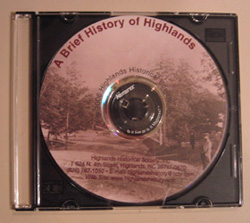 DVD: A BRIEF HISTORY OF HIGHLANDS DVD: A BRIEF HISTORY OF HIGHLANDS
A visual history of the origin and growth of Highlands, N.C., from before 1875 until 2006. Features 64 historical photographs of Highlands in its early years.
Recipient of the North Carolina Society of Historians Multimedia Award, 2007
Published by Time Capsule Video, 2006
|
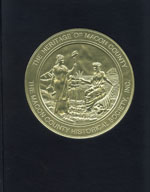 THE HERITAGE OF MACON COUNTY, VOLUME II THE HERITAGE OF MACON COUNTY, VOLUME II
(Contributor)
Our lives should be recorded, for no child really knows his, or her, parents. Unless parents record their own stories, their lives will likely fade into the darkness of oblivion right along with their earlier ancestors. No one can write about your life and feelings with more authority than you.
We seldom pause to consider that the persons of today are the final chapter of our earlier ancestors. Our successes are a compliment to our ancestors, and when we record our own lives, we are leaving a record from which future generations may draw encouragement and knowledge.
This volume includes many family stories of the people of Macon County, North Carolina, not only to assist the present generation but also for those who will come later.
Published by Macon County Historical Society, 1998
|
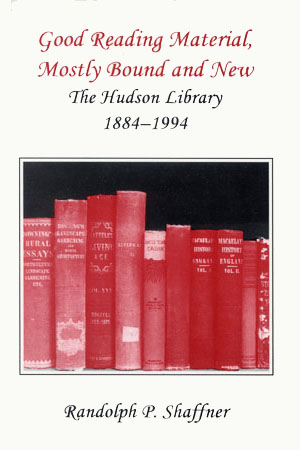 THE HUDSON LIBRARY, 1884-1994 THE HUDSON LIBRARY, 1884-1994
This book narrates the 110-year history of the Hudson Library of Highlands, the second oldest library in North Carolina. It focuses on the community leaders who founded and sustained the library and on the changing literary taste of its patrons through the years.
From its beginning in the post-Civil War era, Highlands has been a favorite mountain resort of easterners, so it has drawn many well-known people in the performing, fine, and literary arts. Set in a biologically unique area, the community has also drawn scientists and naturalists of importance. These cultural leaders figured prominently in the history of the library, both as officers of the institution and as patrons. Like its officers and patrons, the library has developed a personality of its own as it matured into a full-service institution possessing permanent collections of a sophistication well above the norm for communities the size of this small mountain village.
Published by the Hudson Library, 1994
See "Books Available" at Highlands Historical Society or Amazon.
Reviews
"I know of nothing else quite like this. Into the history of a town library, Ran Shaffner has woven stories of the town and its growth, as well as many of its people and all manner of evidence of books. I think book lovers of all types will love the memories it evokes."
—John Ehle
"The original and delightful addition to Shaffner’s history is his skillful interweaving of local and world events. The small community is not isolated from the larger world."
—Wilma Dykeman |
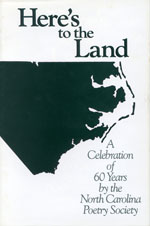 HERE'S TO THE LAND: HERE'S TO THE LAND:
A CELEBRATION OF 60 YEARS BY THE N.C. POETRY SOCIETY
(Contributor)
"A strong sense of place is a defining quality in the best of Southern, and North Carolina, prose and poetry. Add to this the emphasis on people and a heightened awareness of time by a great many poets and we have a natural division of the poetry contained in this volume, published to celebrate the 60th anniversary of the North Carolina Poetry Society."
—Sam Ragan
Published by N.C. Poetry Society, 1992 |
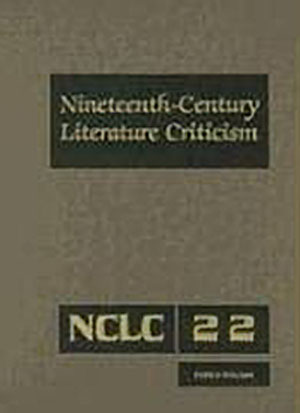 NINETEENTH CENTURY LITERATURE CRITICISM NINETEENTH CENTURY LITERATURE CRITICISM
VOLUME 22
(Contributor)
Excerpts from criticism of the works of nineteenth-century novelists, poets, playwrights, short-story writers, and other creative writers. Each print volume in this long-standing series profiles approximately four to eight literary figures who died between 1800 and 1899 by providing full-text or exerpted criticism taken from books, magazines, literary reviews, newspapers, and scholarly journals. Among those profiled in this volume are Thomas Carlyle, Johann Wolfgang von Goethe, Geraldine Jewsbury, and Thomas Love Peacock.
Published by Gale, 1989 |
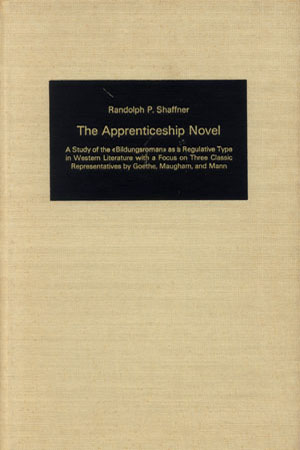 THE APPRENTICESHIP NOVEL THE APPRENTICESHIP NOVEL
The idea that a young person can become adept in the art of life by passing through definite stages, until at last he becomes a master, lives at the core of the apprenticeship novel. Recognized among German critics as the "Bildungsroman," this type of novel has yet to be adequately defined on a grand scale for the English reader despite nearly two centuries of its development.
In an attempt to describe the apprenticeship novel as a modifiable type in Western literature, Dr. Shaffner makes no pretense at formulating a prescriptive norm but rather suggests a theoretical stance from which potential candidates of the type can be seen as concrete examples. Three such examples, representing three stages in a complete apprenticeship to life and death, are Goethe's Wilhelm Meister's Apprenticeship, Somerset Maugham's Of Human Bondage, and Thomas Mann's Magic Mountain.
This book is intended for scholars of German, English, French, American, and comparative literatures in general and students of Goethe, Somerset Maugham, and Thomas Mann in particular.
Published by Peter Lang Publishing, 1984
Reviews
"The novels treated illustrate three phases of character development, according to Shaffner; the recognition of illusory aspects of experience, apprenticeship to life, and finally, apprenticeship also to death. The first stage is reached by the Maugham character, the second by Wilhelm Meister, and all three by Hans Castorp in the Magic Mountain. A particular strength of this study, one of few considerations of the apprenticeship novel in English, is the insight afforded into Maugham's understanding of Wilhelm Meister. An attempt is also made to recommend Goethe's novel to contemporary readers. . . . Recommended for students at undergraduate and graduate levels and for general readers."
—E. Glass, Rosemont College, Choice, September 1984
"In addition to writing at some length about Wilhelm Meister, Of Human Bondage, and The Magic Mountain, Shaffner summarizes previous work on the apprenticeship novel, establishes fundamental principles, and cites many examples of the genre."
—Journal of Modern Literature, Vol. 12, No. 314 (November 1985)
Pages 22-27 are quoted for their focus on characteristics, types, and definitions of the Bildungsroman in a general survey of the genre.
—Nineteenth-Century Literature Criticism, Vol. 22, pp. 108-13
"Among the countless studies of the Bildungsroman, or apprenticeship novel, an extremely useful guide is that provided by Randolph P. Shaffner in his 1985 book The Apprenticeship Novel: A Study of the ‘Bildungsroman’ as a Regulative Type in Western Literature with a Focus on Three Classic Representatives by Goethe, Maugham and Mann. It is perhaps demonstrative of the difficulties surrounding any 'definitive' classification of the apprenticeship novel that Shaffner, who from the outset makes it clear that it is not his goal to provide 'the' true answer, nonetheless at one point arrives at a list of no fewer than 23 'concrete potentialities,' 5 characteristic 'presuppositions' and 8 'additional qualities.'”
—Matthew Fentem, Dark Apprenticeships: The Novels of John Irving (July 2012) |
|
